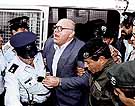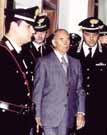
|
|
|

|

|

|

|
|
Click on an image to see a larger, more detailed picture.
|
|
|
|
|
| EPILOGUE: The Aftermath |

|
pg. 669 |

|
|
|
|
| |
 Beate Klarsfeld was one of the more prominent and dedicated "Nazi hunters" to emerge postwar. Here she greets Israeli Prime Minister Yitzhak Rabin in July 1975.
Beate Klarsfeld was one of the more prominent and dedicated "Nazi hunters" to emerge postwar. Here she greets Israeli Prime Minister Yitzhak Rabin in July 1975.
Photo: Archive Photos
|
 Ukrainian-born John Demjanjuk, suspected of being "Ivan the Terrible," the infamous Treblinka gas-chamber operator, was released by prosecutors because of a lack of evidence. However, the U.S. Justice Department linked him to other death camps.
Ukrainian-born John Demjanjuk, suspected of being "Ivan the Terrible," the infamous Treblinka gas-chamber operator, was released by prosecutors because of a lack of evidence. However, the U.S. Justice Department linked him to other death camps.
Photo: Reuters/Jim Hollander/Archive Photos
|
 In March 1998 former SS officer Erik Priebke received a life sentence for ordering the massacre of 335 Italian civilians, including 75 Jews, at the Ardeatine Caves outside of Rome in 1944. He subsequently appealed his case.
In March 1998 former SS officer Erik Priebke received a life sentence for ordering the massacre of 335 Italian civilians, including 75 Jews, at the Ardeatine Caves outside of Rome in 1944. He subsequently appealed his case.
Photo: Reuters/Paul Hanna/Archive Photos
|
|
Germany is not the only country that has needed to deal with people who destroyed Jewish life during the Holocaust. In the United States, for example, the Department of Justice established its Nazi-hunting Office of Special Investigations (OSI) for that purpose in 1979. Since that time, 61 ex-Nazis have been stripped of U.S. citizenship and 49 have been removed from the United States. The OSI's "watch list" program has prevented entry to 150 suspected Nazi war criminals, and in 1999 the OSI had more than 250 persons under investigation. Intense scrutiny has been directed, in particular, against Ukrainian-born John Demjanjuk, a retired auto worker from Cleveland, Ohio, who had immigrated to the United States in 1951 and became a naturalized citizen in 1958. In 1986 Demjanjuk was extradited to Israel, where he stood trial for crimes against humanity. He was cleared, however, when evidence from the Soviet Union cast doubt that he was the infamous Treblinka gas-chamber operator known as "Ivan the Terrible." The U.S. Justice Department initiated proceedings in a federal court on May 19, 1999, to strip Demjanjuk of his U.S. citizenship. Demjanjuk may not have been at Treblinka, but the Justice Department charged that he was, among other things, an armed guard at Sobibór and Majdanek, two notorious Nazi death and concentration camps on Polish soil where hundreds of thousands of Jews were murdered during the Holocaust. The U.S. criminal code has lacked provisions relating explicitly to war crimes. However, falsification of information pertaining to citizenship applications has been used in the United States as a basis to remove citizenship and facilitate deportation for war-crimes suspects. If the government's case against Demjanjuk is successful--it was pending at the time of this writing--he will likely be deported to his native Ukraine. Controversial Scholarship Meanwhile, Germany's Memorial to the Murdered Jews of Europe appears as the perpetrators' generation disappears. As the clashes in Cologne and Saarbrücken illustrate, however, repercussions with regard to post-Holocaust German identity are not likely to be silenced any time soon.
|
|

|

|

|

|
 September 10, 1952: Israel and West Germany sign the Luxembourg Treaty: West Germany will pay reparations to Israel and Jewish organizations for Nazi genocide. Of an $820 million payment, $750 million will go to the Israeli government; See 1990.
September 10, 1952: Israel and West Germany sign the Luxembourg Treaty: West Germany will pay reparations to Israel and Jewish organizations for Nazi genocide. Of an $820 million payment, $750 million will go to the Israeli government; See 1990.
|
 November 9, 1952: Chaim Weizmann, first president of Israel, dies.
November 9, 1952: Chaim Weizmann, first president of Israel, dies.
|
 1953: The Israeli parliament declares a Day of Holocaust Heroism.
1953: The Israeli parliament declares a Day of Holocaust Heroism.
|
 1953: I. A. Topf und Söhne (I. A. Topf & Sons), manufacturer of gas chambers and crematoria during the war, is granted a patent for a method of fueling furnaces with animal fat.
1953: I. A. Topf und Söhne (I. A. Topf & Sons), manufacturer of gas chambers and crematoria during the war, is granted a patent for a method of fueling furnaces with animal fat.
|
 1955: Franz W. Six, former SS-Brigadeführer and commander of Einsatzgruppe B, is released from prison after serving seven years of a 20-year sentence for war crimes.
1955: Franz W. Six, former SS-Brigadeführer and commander of Einsatzgruppe B, is released from prison after serving seven years of a 20-year sentence for war crimes.
|
|
|
|
|
| EPILOGUE: The Aftermath |

|
pg. 669 |

|
|
The Holocaust Chronicle
© 2009 Publications International, Ltd.
|
|
